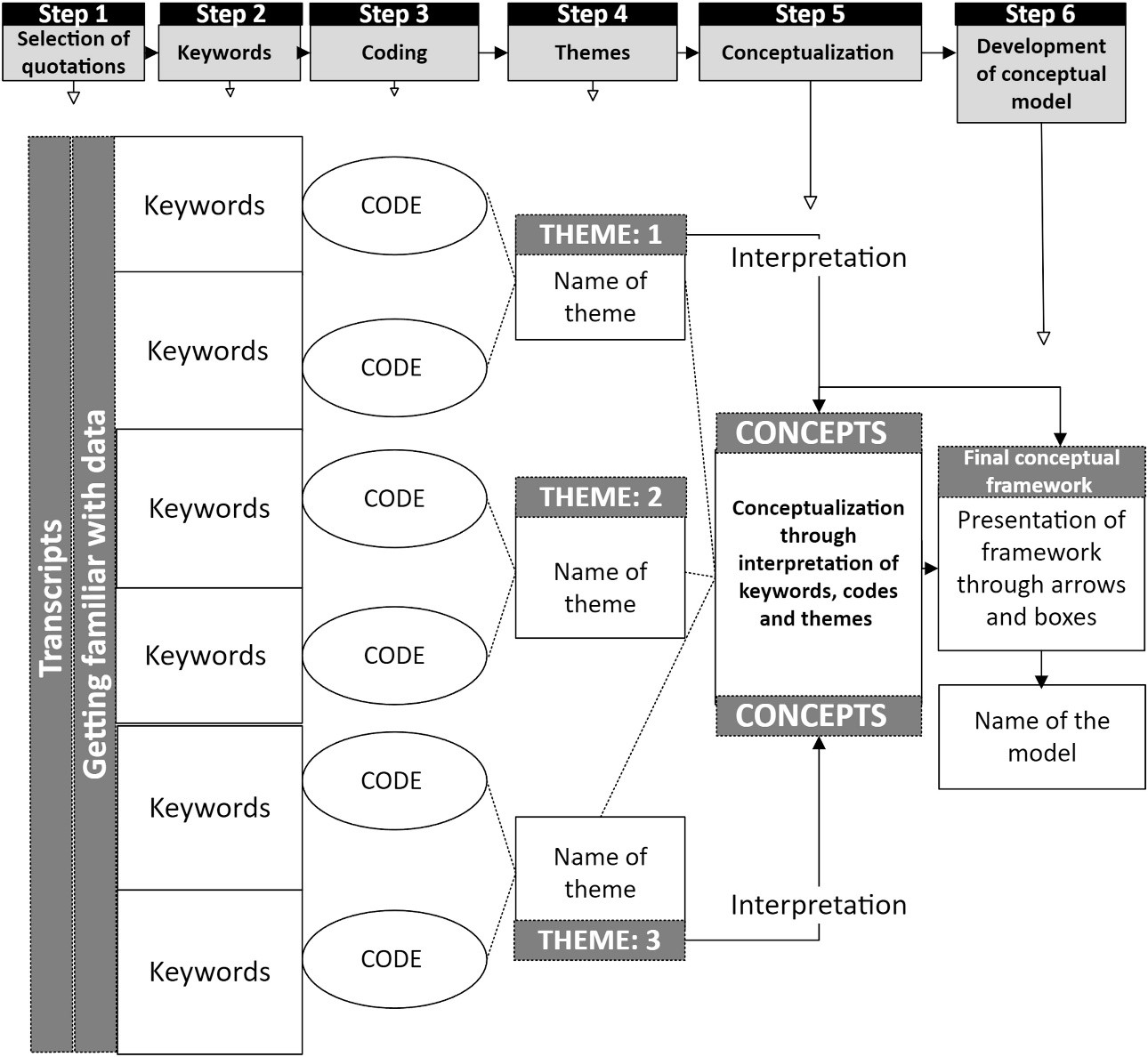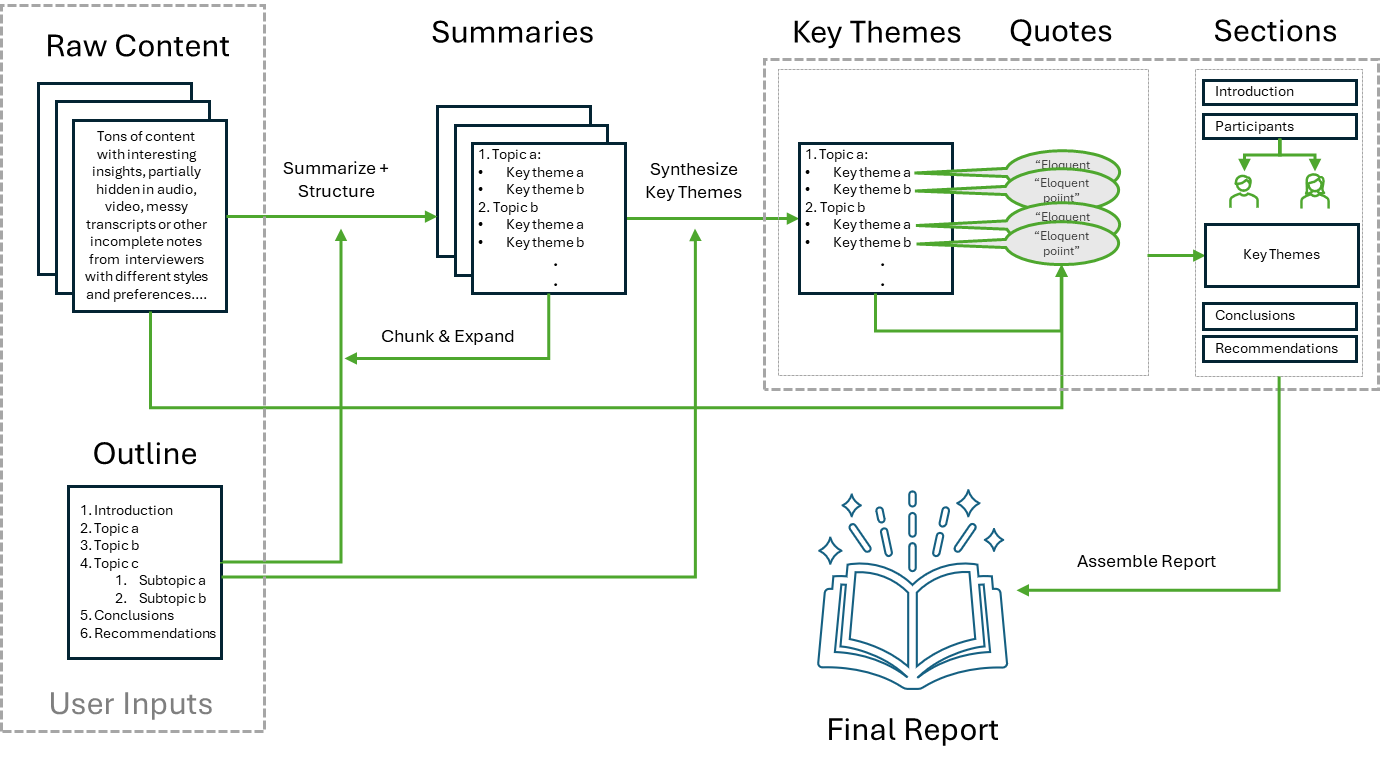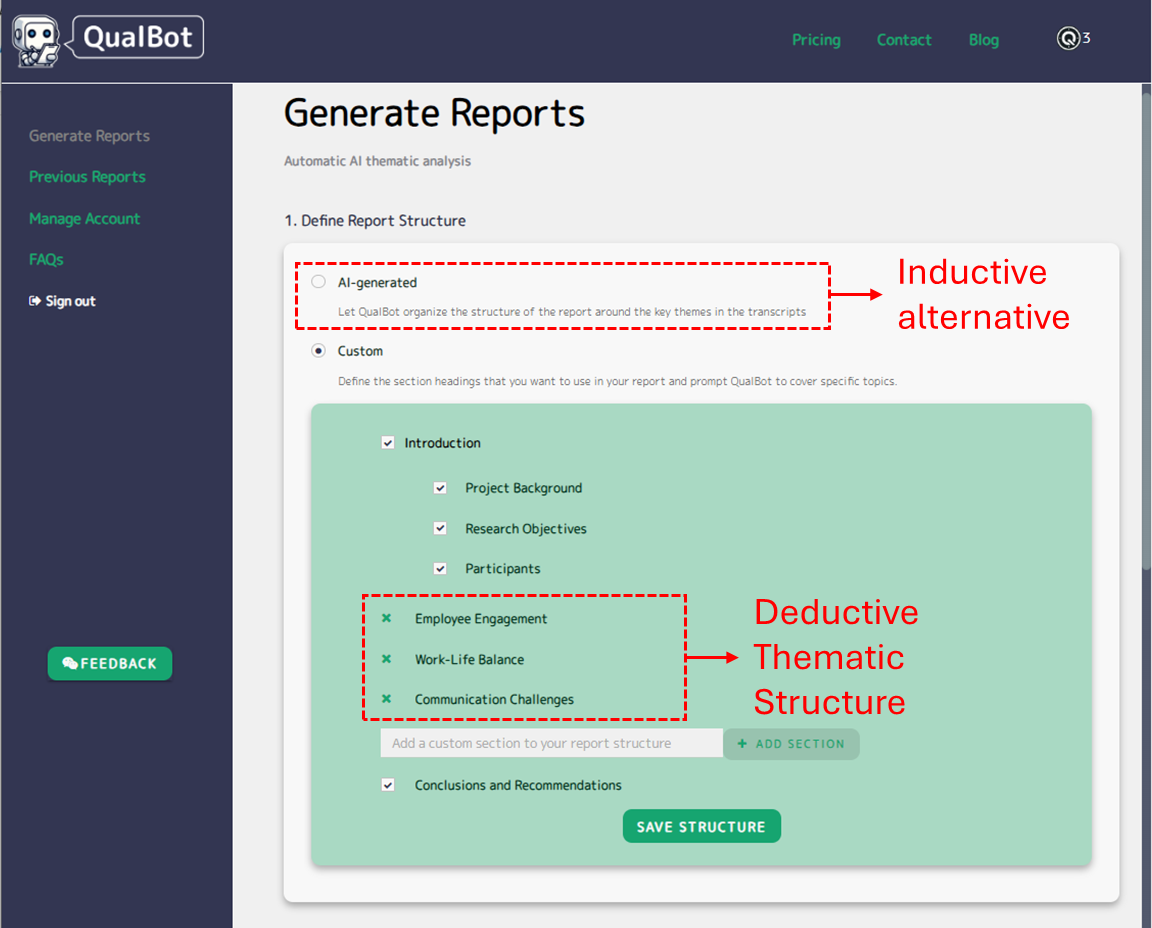What is Thematic Analysis?
Thematic analysis (TA) is a qualitative research method used to systematically identify, analyze, and interpret patterns or themes within a data set. TA involves several steps, including the selection of key data elements, coding, theming, and interpretation, ultimately leading to the development of a conceptual model that encapsulates the research findings.
TA can be applied across constructivist, positivist, and grounded theory approaches, and can adapt to different qualitative methodologies like ethnography and narrative studies. Naeem et al. (2023) break down the process into six steps, including:
- Transcription and Familiarization: This initial phase involves transcribing the data and immersing oneself in it to identify early themes and select quotes that represent diverse viewpoints relevant to the research objectives.
- Selection of Keywords: Researchers identify recurring patterns which are then categorized as keywords that reflect participants’ experiences and perceptions.
- Coding: In this phase, short phrases or codes are assigned to segments of data, representing its core messages. These codes help simplify complex data and form the backbone of subsequent analysis.
- Theme Development: Researchers group related codes to identify broader patterns or relationships, creating themes that offer insights into the research questions.
- Conceptualization: In this step, researchers interpret the emerging themes, refining social patterns into concepts that align with the study’s goals. Diagrams or models can be used to visualize these relationships.
- Development of a Conceptual Model: The final step involves creating a conceptual model that encapsulates the key findings, offering a structured representation of the data that answers the research questions and contributes to theory.
0
TA can be inductive or deductive. Inductive TA, also known as unstructured TA, draws themes, codes, and categories directly from the data. This “bottom-up” approach focuses on uncovering meaning from the data itself, allowing for new insights to develop organically.
Pros
- Generates insights directly from the data.
- Encourages discovery of unexpected themes.
- Provides flexibility to adjust to emerging patterns.
Cons
- Requires significant time for data immersion and interpretation.
- Identifying patterns without a predefined framework can be difficult, especially for less experienced researchers.
- Practicing reflexivity enhances theme development but can be time-consuming.
Deductive TA, also known as structured TA, establishes themes, codes and categories a priori, before the analysis starts. This “top-down” approach uses data as a foundation for theme development, but the analysis and coding are shaped by the theoretical ideas the researcher intends to explore.
Pros
- Provides a theory-based approach to data interpretation.
- Facilitates testing and refining existing theories.
- Leads to more efficient theme development.
Cons
- May miss new or unexpected themes that fall outside the theoretical framework.
- Can lead to confirmation bias, prioritizing data that supports the initial theory.
- Requires thorough application of the theoretical framework to fully capture the data’s complexity.
QualBot implements an AI-native approach to TA, leveraging the capabilities of state-of-the-art LLMs to synthesize large amounts of data, while ensuring the outputs remain consistent with ground truth using semantic indexing and Retrieval Augmented Generation. QualBot implements an agentic workflow to that can be summarized in the following 5 major steps:
- User Inputs: Users upload raw qualitative data, which may include incomplete or unstructured interview transcripts from in-depth interviews or focus group discussions. This corresponds to step 1 of TA (Transcription and Familiarization), where the algorithm processes and immerses itself in the raw data to begin identifying early themes.
- Theme Extraction: The algorithm analyzes the data and extracts key themes, associating them with various topics. These themes are the core findings from the qualitative data. This corresponds to both Step 2: Selection of Keywords and Step 3: Coding, where recurring patterns are detected and categorized into themes or keywords, simplifying the raw data.
- Quote Selection: The algorithm then identifies quotes that are eloquent or representative of each theme. These quotes are then mapped to the corresponding themes. This phase is closely related to Step 4: Theme Development, where the system consolidates quotes and data points around identified themes.
- Report Outline and Assembly: The themes and quotes are then organized into a report structure, which includes sections such as Introduction, Participants, Key Themes, Conclusions, and Recommendations. Each section pulls relevant themes and quotes to construct a coherent narrative for the report. This is connected to Step 5: Conceptualization, where the algorithm starts organizing the themes into a coherent structure, reflecting patterns that address the research objectives.
- Final Report Generation: The output is a complete qualitative report, structured around the user inputs, key themes, and selected quotes. This matches Step 6: Development of a Conceptual Model, where the final structured representation of the data is generated in the form of a report that encapsulates the findings.
QualBot also makes it super-easy to implement either inductive or deductive TA through its flexible report structure functionality. When users select the “AI-generated” option, QualBot automatically analyzes the transcript data, extracting themes directly from the content without pre-existing categories. This aligns with the inductive approach, where themes emerge naturally from the data itself in a “bottom-up” fashion, allowing unexpected patterns to surface. It ensures that the report reflects the data’s intrinsic story, staying free from predefined frameworks or theories.
Furthermore, QualBot addresses the limitations of inductive TA approach by minimizing the time required for data understanding and automatically incorporating an agentic reflection process that reduces the risk of researcher bias.
In the “Custom” mode, users can define the section headings and topics (e.g., Employee Engagement, Work-Life Balance, Communication Challenges), which prompts QualBot to explore the data within these pre-established categories. This represents a deductive approach to TA, where the themes are theory-driven, chosen a priori, and used to guide the analysis. It reflects a “top-down” structure, focusing the analysis on specific theoretical frameworks or concepts from the outset.
As in the inductive approach, QualBot minimizes the limitations of deductive TA approach by capturing misaligned themes under an “other merging themes” section, reducing the chances of missing an important theme. Its agentic reflection process also ensures the thorough application of the theoretical framework to fully capture data complexity and reduces the risk of confirmation bias.
QualBot simplifies the thematic analysis process by offering both inductive and deductive approaches, catering to diverse research needs. As an AI-native app, it not only automates the labor-intensive task of data synthesis but also enhances both accuracy and depth by integrating agentic reflection—a self-improving mechanism that strengthens the analysis.
Whether you prefer to let themes organically emerge from your data or work within predefined frameworks, QualBot ensures a seamless, efficient, and reliable workflow. By leveraging advanced machine learning techniques such as semantic indexing and Retrieval Augmented Generation, QualBot transforms qualitative research, making it more precise and adaptable to large datasets. Its ability to mitigate biases and overcome limitations of traditional thematic analysis makes it an indispensable tool for researchers aiming to produce well-structured, insightful reports.
Ready to save time and deepen your research analysis? Start using QualBot today to unlock new insights in your qualitative research. Try QualBot for free and experience the difference yourself!
What challenges have you faced with traditional qualitative research methods? How do you think AI could help? I’d love to hear your feedback—let us know how we can improve and make QualBot even better for you.
Sources: Naeem, M., Ozuem, W., Howell, K., & Ranfagni, S. (2023). A step-by-step process of thematic analysis to develop a conceptual model in qualitative research. International Journal of Qualitative Methods, 22, 16094069231205789.




